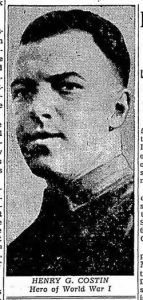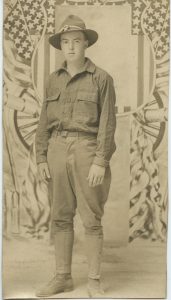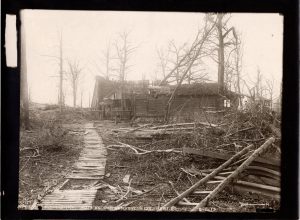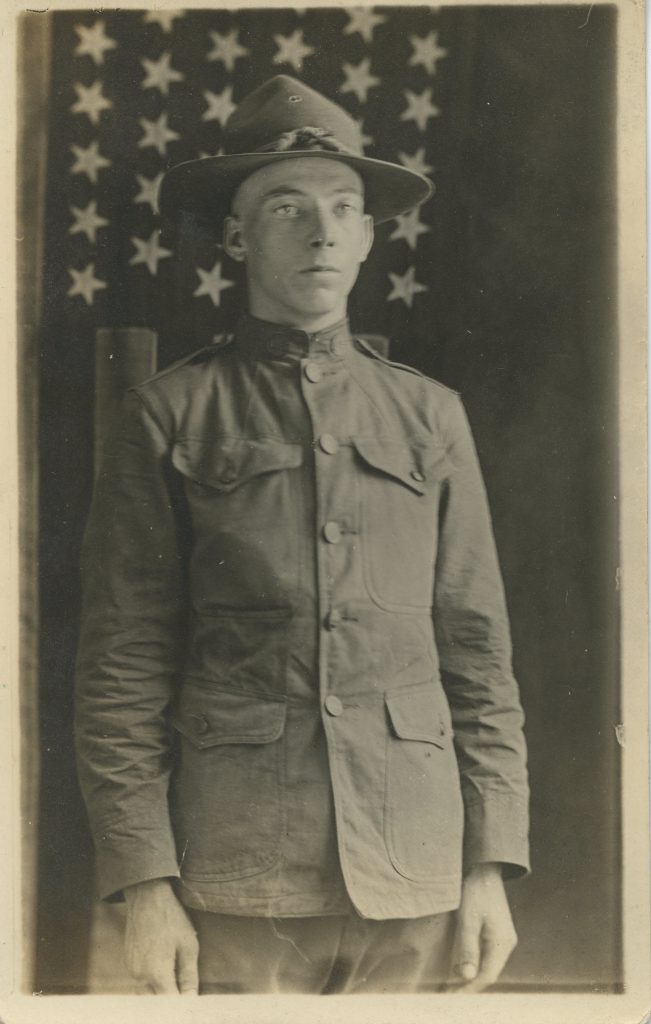A look back at history — Medal of Honor recipient Henry Gilbert Costin
Sgt. 1st Class Aaron Heft
Historical NCO

BALTIMORE — March 25th is nationally recognized as “Medal of Honor Day,” marking the anniversary of the first issuance of the Medal of Honor in 1863 to five soldiers during the American Civil War. Over the course of the awards history 67 Maryland born Soldiers, Sailors, and Marines have earned the medal for valor in action. Marylanders have been among those awarded the nation’s highest honor in nearly every conflict since its creation, but the first Maryland National Guardsman to earn the medal was a 20-year-old Private from Baltimore.
Henry Gilbert Costin was an atypical Guardsman of the World War I era. He had been a high school and college athlete, had graduated from Baltimore City College in 1915, and worked in the city at the J.R. Dunn Mercantile Agency. When the National Guard received orders to mobilize for the Mexican Border in 1916, Costin left behind a profitable civilian career and enlisted with the old 5th Maryland Infantry as a Private.[ii] Costin gained valuable experience on the border as the 5th drilled and patrolled alongside other Guardsman in Eagle Pass, Texas. Just a few weeks after returning home from Texas, Costin’s unit was called up again as part of the National Guard’s mobilization for WWI. He was initially assigned to guard military stores in Baltimore, and while a patrolling Coast Guard property he met, courted, and married Hythron Johnson, the daughter of a Coast Guard Captain.
college athlete, had graduated from Baltimore City College in 1915, and worked in the city at the J.R. Dunn Mercantile Agency. When the National Guard received orders to mobilize for the Mexican Border in 1916, Costin left behind a profitable civilian career and enlisted with the old 5th Maryland Infantry as a Private.[ii] Costin gained valuable experience on the border as the 5th drilled and patrolled alongside other Guardsman in Eagle Pass, Texas. Just a few weeks after returning home from Texas, Costin’s unit was called up again as part of the National Guard’s mobilization for WWI. He was initially assigned to guard military stores in Baltimore, and while a patrolling Coast Guard property he met, courted, and married Hythron Johnson, the daughter of a Coast Guard Captain.
Costin and the 5th were soon sent to Camp McClellan, Alabama where they were combined with units from Washington D.C., Virginia, and New Jersey to form the new 29th Division. The 5th would be combined with other Maryland units to form the 115th Infantry, and Costin was assigned to Company H.[iv] After a short training period, the Division shipped to France in June of 1918 and joined other members of the American Expeditionary Force (AEF) training in country.
 Costin’s first combat action came in the Alsace sector in September. The 115th was manning a “quiet” portion of the line when it came under intense gas and shell fire. Despite being badly gassed in the attack, Private Costin fought through his injuries and helped to escort wounded men back to safety. For his actions during the September 18th attack, the French Army (in command of the sector) would award Costin the Croix de Guerre for battlefield heroism.
Costin’s first combat action came in the Alsace sector in September. The 115th was manning a “quiet” portion of the line when it came under intense gas and shell fire. Despite being badly gassed in the attack, Private Costin fought through his injuries and helped to escort wounded men back to safety. For his actions during the September 18th attack, the French Army (in command of the sector) would award Costin the Croix de Guerre for battlefield heroism.
After recovering in the hospital Costin returned to Company H as it prepared for its greatest action of the war. As the American advance in the Meuse-Argonne stalled, the 29th Division was ordered to launch an offensive operation on the heights of the Meuse River on October 8th, 1918. Costin and the 115th were ordered to clear the Consenvoye Woods, including the heavily fortified position at Molleville Farm. After initial success, the 115th ran into heavy fire from concealed German Machine gun nests. Lieutenant Patrick Regan, Costin’s Platoon Leader asked for volunteers to help flank and clear the nests. Costin shouldered his Chauchat Automatic Rifle and was the first volunteer, he joined Regan and two others in an assault on the nests.
Under German machine gun and artillery fire the party advanced until every member was killed or wounded. Despite grievous injuries, Costin refused to leave his automatic rifle, and continued suppressive fire allowing Regan and the wounded survivors to clear the enemy position and capture over 100 German and Austrian prisoners. Costin succumbed to the effects of his wounds shortly after the position was cleared. The unit would fight on to clear the remaining woods in the heights until finally withdrawn October 16th.

From a hospital a few days later, Lieutenant Regan would write to Costin’s wife “He died that others might live. His prompt and effective use of the weapon he was armed with no doubt saved the company many casualties, and it was regrettable that he should die after such brilliant work…his record is one that any man may well be proud of, and he will never be forgotten by members of Company H.”[vii] Just months after the 29th Division returned home, in April of 1919, Costin’s wife Hythron would receive Costin’s posthumous Medal of Honor from General Buck, commander of Camp Meade in a widely attended ceremony in Baltimore.
Costin’s memory was never forgotten by the Maryland National Guard. A memorial to him and another Baltimore Medal of Honor Recipient was built across the street from the 5th Regiment Armory, and during World War II a Liberty Ship would be named in his honor. Today, the Laurel Armory where Maryland National Guard Soldiers still train is named in his honor, a fitting tribute to one of Maryland’s most heroic Privates.

